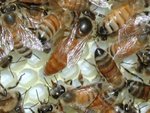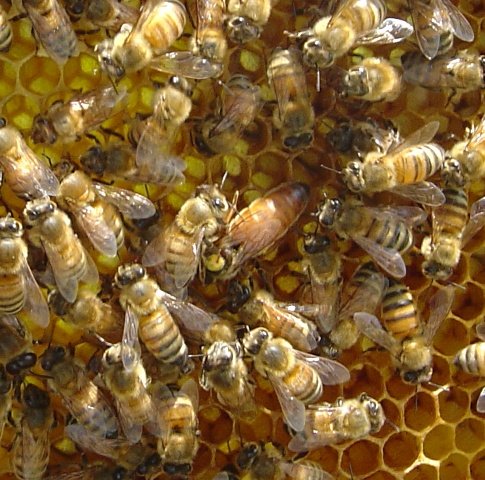On September 1st we removed and extracted the honey from our hives here on the Cape. As suspected and commented on in previous posts it was a very lean year honey wise.
With the potential to produce 350 pounds of honey our hives produced only 28 pounds. Some beekeepers in our area did not get any honey from there hives this year. The combination of a very cold spring, and a very dry summer created no abundance of nectar. What little the bees collected was used to keep the hive running.
With the potential to produce 350 pounds of honey our hives produced only 28 pounds. Some beekeepers in our area did not get any honey from there hives this year. The combination of a very cold spring, and a very dry summer created no abundance of nectar. What little the bees collected was used to keep the hive running.
Right: A frame of capped honey
.
.
.
.
.
.
.
.
.
.
.
.
.
The process of extracting honey consists of first removing the honey supers from the hives. To achieve this, bee escape boards are placed between the honey supers (boxes) and the brood chamber (where the bees raise their young). Over a few days the bees leave the honey super and are unable to return to it through the escape board. The honey boxes can then be removed.
.
Left: Uncapping the honey comb with a hot electric knife
.
.
.
.
.
.
.
.
.
.
.
.
.
.
.
.
.
.
Honey is produced by the collection of nectar from the local flowers. The nectar contains about 1% sugar. The bees collect the nectar and store it in the cells of the comb. The water is evaporated from the nectar leaving only the sugar behind. Once the honey is “ripe” (completed) the bees cap over the cells with a white wax. The wax capping seals the cells and keeps the honey from absorbing moisture from the air. The honey is now sealed in a air tight container of wax. Normally the bees would save the honey and use it as food during the winter months. The cell would be uncapped when the honey was needed as food. Fortunately for the beekeeper bees are hoarders of honey. They will produce much more honey than they need to survive the winter.
The Beekeeper can take for himself what the bees will not need. Yum.
The extraction process starts with the removal of the white wax cappings. A hot electric knife is used to cut the wax cappings off the comb exposing the liquid honey in the cells. Frames of honey which are not capped are not extracted. Uncapped honey may contain excess water which will in time cause the honey to ferment. Only ripe capped honey comb is extracted.
Once the frame of honey is uncapped it is placed in a centrifuge (extractor). The comb is spun in the extractor and centrifugal force causes the liquid honey out of the comb and into the extractor. The empty combs are then removed and stored to be used again next season.
.
.
Right: Our two fram hand crank extractor
.
.
.
.
.
.
.
.
.
.
.
.
.
.
.
The best part of extracting is the sent of hot honey produced by the electric uncapping knife. The smell is indescribably sweet.
Once the honey gate is open liquid honey pours out into a series of screens designed to remove any wax which may be in the honey. The honey drips through the screens into a honey bucket. Each bucket holds about 60 pounds of honey.
The honey is stored for 24 hours which allows any small particles of wax to float to the top of the honey bucket. The honey is then poured from the bottom of the pail through a honey gate and into the bottles.
Each years honey is different from the previous years, depending on what flowers the honey was collected from. As you can see, this years honey was very dark, compared to last years honey which was very golden.
Once the honey gate is open liquid honey pours out into a series of screens designed to remove any wax which may be in the honey. The honey drips through the screens into a honey bucket. Each bucket holds about 60 pounds of honey.
The honey is stored for 24 hours which allows any small particles of wax to float to the top of the honey bucket. The honey is then poured from the bottom of the pail through a honey gate and into the bottles.
Each years honey is different from the previous years, depending on what flowers the honey was collected from. As you can see, this years honey was very dark, compared to last years honey which was very golden.
.
Left: Extracted liquid honey pouring into the filter screens
.
.
.
.
.
.
.
.
.
.
.
.
Once the honey is removed from the hive, preparations begin for the over wintering of the hives.
But more about that next time.











what is "colony collapse disorder" ?
ReplyDeleteYour map is too small to read.
Your site is very nice. Thanks for putting it up. Can you recommend reference material for a beginner?
keith rowell
It is rather interesting for me to read the article. Thank you for it. I like such topics and anything that is connected to this matter. I would like to read a bit more soon.
ReplyDeleteKeep on posting such articles. I love to read stories like that. By the way add some pics :)
ReplyDelete